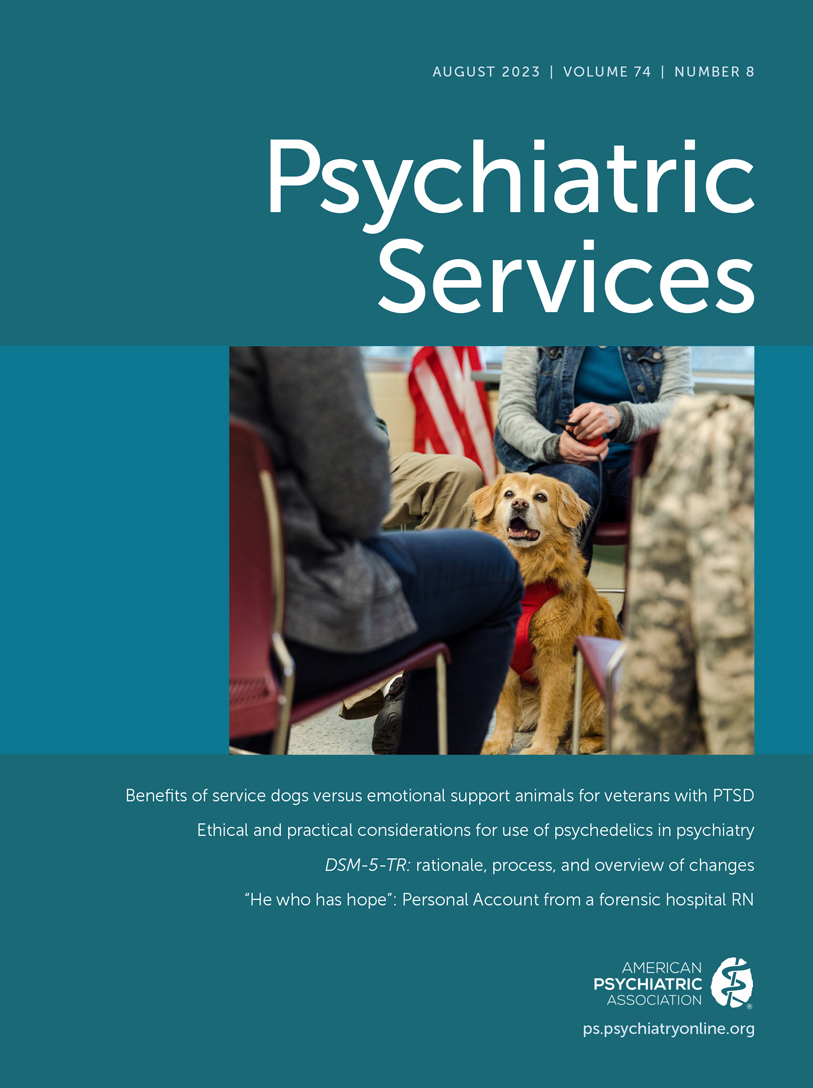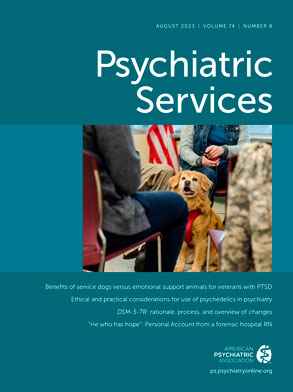Early death due to medical conditions among individuals with mental illnesses has been extensively documented (
1–
4). The World Health Organization estimates a 10- to 20-year reduction in life expectancy among those with such disorders globally (
5), including the United States (
2). When considering reduced life expectancy, both the cause of death (
4) and the setting where death occurs are important considerations (
1) to understand and avoid preventable deaths among individuals treated for mental illnesses. In this report, we compare the prevalence of in-home, natural deaths among individuals receiving treatment for mental illnesses with that of the general population in New York State, excluding New York City. Because in-home, natural deaths in some instances may point to gaps in health care service delivery and policy, any disparities would warrant deeper examination.
The New York State Incident Management and Reporting System (NIMRS) is a secure, online platform used by providers to report incidents, including all deaths of individuals receiving mental health services, in accordance with state regulations. In addition to state-run facilities, every Office of Mental Health–licensed agency is required to report deaths to NIMRS as part of their licensure. Because of an observation of a high rate of in-home, natural deaths (compared with deaths occurring in other settings, such as hospitals and hospices) among those receiving mental health treatment, we collaborated with the Bureau of Vital Records (BVR) at the New York State Department of Health to explore differences in the prevalence of in-home, natural deaths between persons receiving treatment for mental illnesses and the state’s general population. We hypothesized that those being treated for mental illnesses would have a higher rate of in-home deaths.
Methods
This study was limited to deaths of adults in New York State, excluding New York City. From a deidentified BVR data set spanning the 2016–2018 period, we identified in-home, natural deaths by filtering the data by place of death as “decedent’s residence” and by using
ICD-10 codes to identify deaths due to natural causes (i.e., excluding accidents, homicides, and suicides). All adult deaths that occurred during 2016–2018 (N=300,684) were used as the denominator for prevalence calculations (using data publicly available at
https://www.health.ny.gov/statistics/vital_statistics/vs_reports_tables_list.htm). Although the BVR data for the general population also included individuals treated for mental illnesses (i.e., deaths recorded in the NIMRS database described below), we assumed that use of these general population data would have little impact on results and that any impact would bias findings toward the null hypothesis. Furthermore, deaths among individuals ages 18–19 years were not included in the denominator of the prevalence calculation in the general population, although they were in the numerator data from the BVR (BVR numerator data ranges were 18–24, 25–34, and so forth; however, the denominator data ranges were 10–19, 20–24, 25–34, etc.). Sensitivity analyses revealed negligible changes to the rates of in-home, natural deaths overall and in the 18–24 age group of the general population.
For rates of in-home, natural deaths among individuals receiving treatment for mental illnesses recorded in the NIMRS data set (all adult deaths reported to NIMRS during 2016–2018; N=3,991), we extracted number of deaths as the numerator through the following steps. First, cases with a “final incident subtype” reported as suicide, homicide, or accidental or left blank were excluded. Next, cases with “service type description” reported as “inpatient” and “incident site description” reported as “onsite” (of a mental health service) were also excluded from the numerator. Finally, cases with “location code” reported as a location outside the individual’s residence were also excluded. The NIMRS data set had a substantial number of cases with location code reported as unknown, none, other, or blank. To minimize the effect of these missing data in calculating death prevalence, we reviewed the NIMRS report in depth to identify the location of death for 300 randomly selected cases (in which location code was missing) in the following age categories: 25–34, 35–44, 45–54, 55–64, and >65 (60 cases each). The analysis revealed that in this random sample, 16.7% (N=50 of 300) of cases were in fact in-home deaths. This number was used to project the percentage of potential in-home deaths among cases with missing “location of death” information.
Data were stratified by age, gender, race-ethnicity, and region. As for calculation of death prevalence, steps were taken to minimize the effect of missing data in the NIMRS database. The demographic breakdowns (age, gender, and race-ethnicity) of the 16.7% cases were used in combination with the demographic breakdowns of the known in-home, natural deaths from the NIMRS database. Microsoft Excel was used for all calculations.
Results
Prevalence calculations revealed an in-home natural-death prevalence among individuals being treated for mental illnesses of 0.37 (N=1,457 of 3,991) during 2016–2018. This rate was notably higher than that in the general population (0.26, N=77,551 of 300,684). The actual difference in prevalence rates may even be larger because, as mentioned above, the deaths among those receiving treatment for mental illnesses were also included in the BVR data.
In the general population, most in-home deaths occurred among those age ≥65 years (77.1%), ages 55–64 (13.6%), and ages 45–54 (5.5%) (
Table 1). The respective percentages among those receiving treatment for mental illnesses were 22.6% (age ≥65), 31.3% (ages 55–64), and 26.4% (ages 45–54). These differences are consistent with the known reduced life expectancy among those with mental illnesses. The in-home natural-death prevalence rates among non-Hispanic Black (0.41) and Hispanic (0.38) individuals receiving treatment for mental illnesses were notably higher than those in the general population (non-Hispanic Black, 0.21; Hispanic, 0.22). Among individuals in mental health treatment, in-home natural deaths among non-Hispanic Blacks and Hispanics represented 14.2% and 4.6% of deaths, respectively, compared with 5.5% and 2.8% in the general population, respectively. The in-home natural-death prevalence rates among men and women in mental health treatment (0.37 each) were also higher than those in the general population (0.27 and 0.25, respectively).
Discussion
Many potential drivers could explain the higher prevalence of in-home, natural deaths among individuals in mental health treatment (0.37) compared with the general population (0.26). First, those with mental illnesses may have psychiatric symptoms interfering with early initiation of care for medical symptoms that are harbingers of serious and deadly conditions (e.g., pain in the calf associated with deep-vein thrombosis). Such psychiatric symptoms could include negative symptoms of psychotic disorders, neurocognitive impairments, depressive symptoms, and social or trauma-related anxiety.
Second, persons with mental illnesses are more likely to be unmarried or unpartnered. Thus, they are more likely to live alone, without family who can recognize early symptoms and facilitate initiating care. Third, those with mental health conditions might receive less health education and are less likely to have a primary care provider or to receive preventive and primary care services (
6). Additionally, chronic disease screening and prevention activities often do not occur in mental health clinics (
7).
Fourth, individuals receiving treatment for mental illnesses face many social adversities and structural barriers that increase the risk for general medical illnesses and impede initiation of timely medical care. These barriers include low educational attainment, low income, housing instability, and poor access to transportation. Fifth, although we were unable to examine specific causes of death, it is possible that people with psychiatric disorders have a high prevalence of conditions that cause sudden death (e.g., cardiac arrest) rather than conditions that might have a protracted course, necessitating hospitalization and ultimately death in the hospital setting.
Opportunities for programmatic enhancements in health education and prevention domains could include condition-specific health literacy initiatives. Such initiatives should be codesigned by people with lived experience. Policy-based opportunities could include expanding access to nonemergency medical transportation. The goal would be to help individuals treated for mental illnesses better manage the underlying conditions that ultimately become causes of in-home death. Lack of transportation is a highly cited reason for missed appointments (
8,
9); thus, this issue should be mitigated. Initiatives to develop reliable and affordable nonemergency transportation that meets the needs of people living with chronic comorbid medical conditions is one policy consideration. All programmatic and policy considerations must attend to potential disparities.
This analysis should be considered hypothesis generating rather than confirmatory because of several limitations. First, including the populations from the five New York City boroughs was not possible because BVR data agreements did not allow easy access to data on these populations. Statewide data should be considered for future studies. Taking a closer look at the regional-, county-, or zip code–level data would be a valuable next step.
Second, deaths among those treated for mental illnesses were included in the general population data set because we could not identify and remove these deaths. However, as noted above, this inclusion would reduce, rather than increase, the extent of any observed differences.
Third, some types of death among individuals with diagnosable mental disorders are not captured in NIMRS. For example, deaths among individuals treated for mental illnesses in private practices are not included in NIMRS. Furthermore, we could not obtain the prevalence of in-home, natural deaths among individuals with mental illnesses who were not receiving mental health treatment services; this population could be substantial. Nonetheless, if their death pattern (in-home compared with other settings) is like that for individuals recorded in NIMRS, the difference in prevalence compared with the general population would be even greater.
Fourth, because the location code was missing for some NIMRS reports, we had to impute the percentage of deaths likely to have occurred in home among those reports. Fifth, race and ethnicity were combined into a single variable (e.g., someone who identified as Black and Hispanic was categorized as Hispanic), and the race category of “other” is problematic because it captures multiple racial and ethnic identities (e.g., all Asian people), making interpretations with regard to some racial groups nearly impossible.
Sixth, an in-depth study of the causes of death was not possible because NIMRS does not capture that information. Subsequent research should therefore include cause of death. Finally, the data were not granular enough to distinguish special treatment settings such as hospice programs in an in-home setting.
Conclusions
The emergence in recent decades of data indicating increased early death among individuals with mental illnesses has been alarming. Multiple programmatic and policy priorities must be put in place to reduce the gap in early death between individuals with mental illnesses and the general population. We present evidence of a higher prevalence of in-home, natural deaths among persons receiving treatment for mental illnesses, with notable disparities observed for non-Hispanic Black and Hispanic individuals. Although the setting where death takes place (e.g., in home compared with other settings) does not indicate untimely death per se, the goal of this study was to highlight potentially preventable in-home deaths among those being treated for mental illnesses. These findings may help prompt analyses in other population data sets and, if replicated in other studies, call for programmatic and policy innovations to reduce the observed mortality gap.

